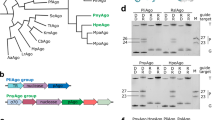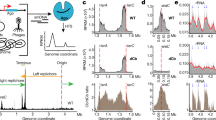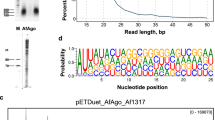Abstract
Prokaryotic Argonaute proteins acquire guide strands derived from invading or mobile genetic elements, via an unknown pathway, to direct guide-dependent cleavage of foreign DNA. Here, we report that Argonaute from the archaeal organism Methanocaldococcus jannaschii (MjAgo) possesses two modes of action: the canonical guide-dependent endonuclease activity and a non-guided DNA endonuclease activity. The latter allows MjAgo to process long double-stranded DNAs, including circular plasmid DNAs and genomic DNAs. Degradation of substrates in a guide-independent fashion primes MjAgo for subsequent rounds of DNA cleavage. Chromatinized genomic DNA is resistant to MjAgo degradation, and recombinant histones protect DNA from cleavage in vitro. Mutational analysis shows that key residues important for guide-dependent target processing are also involved in guide-independent MjAgo function. This is the first characterization of guide-independent cleavage activity for an Argonaute protein potentially serving as a guide biogenesis pathway in a prokaryotic system.
This is a preview of subscription content, access via your institution
Access options
Access Nature and 54 other Nature Portfolio journals
Get Nature+, our best-value online-access subscription
$29.99 / 30 days
cancel any time
Subscribe to this journal
Receive 12 digital issues and online access to articles
$119.00 per year
only $9.92 per issue
Buy this article
- Purchase on Springer Link
- Instant access to full article PDF
Prices may be subject to local taxes which are calculated during checkout





Similar content being viewed by others
References
Willkomm, S., Zander, A., Gust, A. & Grohmann, D. A prokaryotic twist on Argonaute function. Life 5, 538–553 (2015).
Swarts, D. C. et al. The evolutionary journey of Argonaute proteins. Nat. Struct. Mol. Biol. 21, 743–753 (2014).
Meister, G. Argonaute proteins: functional insights and emerging roles. Nat. Rev. Genet. 14, 447–459 (2013).
Elbashir, S. M. et al. Duplexes of 21-nucleotide RNAs mediate RNA interference in cultured mammalian cells. Nature 411, 494–498 (2001).
Elbashir, S. M., Lendeckel, W. & Tuschl, T. RNA interference is mediated by 21- and 22-nucleotide RNAs. Genes Dev. 15, 188–200 (2001).
Zamore, P. D., Tuschl, T., Sharp, P. A. & Bartel, D. P. RNAi: double-stranded RNA directs the ATP-dependent cleavage of mRNA at 21 to 23 nucleotide intervals. Cell 101, 25–33 (2000).
Swarts, D. C. et al. Argonaute of the archaeon Pyrococcus furiosus is a DNA-guided nuclease that targets cognate DNA. Nucleic Acids Res. 43, 5120–5129 (2015).
Swarts, D. C. et al. DNA-guided DNA interference by a prokaryotic Argonaute. Nature 507, 258–261 (2014).
Wang, Y. et al. Structure of an argonaute silencing complex with a seed-containing guide DNA and target RNA duplex. Nature 456, 921–926 (2008).
Wang, Y. et al. Nucleation, propagation and cleavage of target RNAs in Ago silencing complexes. Nature 461, 754–761 (2009).
Zander, A., Holzmeister, P., Klose, D., Tinnefeld, P. & Grohmann, D. Single-molecule FRET supports the two-state model of argonaute action. RNA Biol. 11, 45–56 (2014).
Gao, F., Shen, X. Z., Jiang, F., Wu, Y. & Han, C. DNA-guided genome editing using the Natronobacterium gregoryi Argonaute. Nat. Biotechnol. 34, 768–773 (2016).
Willkomm, S., Zander, A., Grohmann, D. & Restle, T. Mechanistic insights into archaeal and human argonaute substrate binding and cleavage properties. PLoS ONE 11, e0164695 (2016).
Ma, J. B. et al. Structural basis for 5′-end-specific recognition of guide RNA by the A. fulgidus Piwi protein. Nature 434, 666–670 (2005).
Schirle, N. T. & MacRae, I. J. The crystal structure of human Argonaute2. Science 336, 1037–1040 (2012).
Wang, Y., Sheng, G., Juranek, S., Tuschl, T. & Patel, D. J. Structure of the guide-strand-containing Argonaute silencing complex. Nature 456, 209–213 (2008).
Frank, F., Sonenberg, N. & Nagar, B. Structural basis for 5′-nucleotide base-specific recognition of guide RNA by human AGO2. Nature 465, 818–822 (2010).
Nakanishi, K., Weinberg, D. E., Bartel, D. P. & Patel, D. J. Structure of yeast Argonaute with guide RNA. Nature 486, 368–374 (2012).
Kaya, E. et al. A bacterial Argonaute with noncanonical guide RNA specificity. Proc. Natl Acad. Sci. USA 113, 4057–4062 (2016).
Olovnikov, I., Chan, K., Sachidanandam, R., Newman, D. K. & Aravin, A. A. Bacterial Argonaute samples the transcriptome to identify foreign DNA. Mol. Cell 51, 594–605 (2013).
Miyoshi, T., Ito, K., Murakami, R. & Uchiumi, T. Structural basis for the recognition of guide RNA and target DNA heteroduplex by Argonaute. Nat. Commun. 7, 11846 (2016).
Blow, M. J. et al. The epigenomic landscape of prokaryotes. PLoS Genet. 12, e1005854 (2016).
Loenen, W. A., Dryden, D. T., Raleigh, E. A., Wilson, G. G. & Murray, N. E. Highlights of the DNA cutters: a short history of the restriction enzymes. Nucleic Acids Res. 42, 3–19 (2014).
Willkomm, S . et al. Structural and mechanistic insights into an archaeal DNA-guided Argonaute protein. Nat. Microbiol. 2, 17035 (2017).
Elkayam, E. et al. The structure of human Argonaute-2 in complex with miR-20a. Cell 150, 100–110 (2012).
Peeters, E., Driessen, R. P., Werner, F. & Dame, R. T. The interplay between nucleoid organization and transcription in archaeal genomes. Nat. Rev. Microbiol. 13, 333–341 (2015).
Cheloufi, S., Dos Santos, C. O., Chong, M. M. & Hannon, G. J. A dicer-independent miRNA biogenesis pathway that requires Ago catalysis. Nature 465, 584–589 (2010).
Chandradoss, S. D., Schirle, N. T., Szczepaniak, M., MacRae, I. J. & Joo, C. A dynamic search process underlies microRNA targeting. Cell 162, 96–107 (2015).
Schirle, N. T., Sheu-Gruttadauria, J. & MacRae, I. J. Gene regulation. Structural basis for microRNA targeting. Science 346, 608–613 (2014).
Parker, J. S. How to slice: snapshots of Argonaute in action. Silence 1, 3 (2010).
Wagner, M. et al. Expanding and understanding the genetic toolbox of the hyperthermophilic genus Sulfolobus. Biochem. Soc. Trans. 37, 97–101 (2009).
Brock, T. D., Brock, K. M., Belly, R. T. & Weiss, R. L. Sulfolobus: a new genus of sulfur-oxidizing bacteria living at low pH and high temperature. Arch. Mikrobiol. 84, 54–68 (1972).
Berkner, S., Wlodkowski, A., Albers, S. V. & Lipps, G. Inducible and constitutive promoters for genetic systems in Sulfolobus acidocaldarius. Extremophiles 14, 249–259 (2010).
Wagner, M. et al. Versatile genetic tool box for the crenarchaeote Sulfolobus acidocaldarius. Front. Microbiol. 3, 214 (2012).
Rachel, R. et al. Analysis of the ultrastructure of archaea by electron microscopy. Methods Cell Biol. 96, 47–69 (2010).
Acknowledgements
The authors thank all members of the Grohmann laboratory and in particular K. Kramm for cloning of the MjAgo catalytic mutant. The authors thank G. Meister for discussions. Work in the Grohmann RNAP laboratory was funded by the Deutsche Forschungsgemeinschaft (GR 3840/2-1). S.V.A. and M.v.W. acknowledge funding by the European Research Council (starting grant ARCHAELLUM 311523). S.Sc. acknowledges funding by the Deutsche Forschungsgemeinschaft, the excellence cluster CIPSM and Fonds der Chemischen Industrie.
Author information
Authors and Affiliations
Contributions
D.G. conceived the study. A.Z., S.W., M.v.W., L.E., S.St., S.O., A.K., S.B. and D.G. carried out experimental work. A.Z., S.W., M.v.W., S.-V.A., S.Sc., P.T., D.G., A.K. and F.W. performed data analysis. D.G. wrote the manuscript. All authors edited the manuscript.
Corresponding author
Ethics declarations
Competing interests
The authors declare no competing financial interests.
Supplementary information
Supplementary Information
Supplementary Methods and Supplementary Figures 1–13. (PDF 1676 kb)
Rights and permissions
About this article
Cite this article
Zander, A., Willkomm, S., Ofer, S. et al. Guide-independent DNA cleavage by archaeal Argonaute from Methanocaldococcus jannaschii. Nat Microbiol 2, 17034 (2017). https://doi.org/10.1038/nmicrobiol.2017.34
Received:
Accepted:
Published:
DOI: https://doi.org/10.1038/nmicrobiol.2017.34
This article is cited by
-
DNA-targeting short Argonautes complex with effector proteins for collateral nuclease activity and bacterial population immunity
Nature Microbiology (2024)
-
Nucleic-acid-triggered NADase activation of a short prokaryotic Argonaute
Nature (2024)
-
Oligomerization-mediated activation of a short prokaryotic Argonaute
Nature (2023)
-
Bacterial origins of human cell-autonomous innate immune mechanisms
Nature Reviews Immunology (2022)
-
Programmable RNA targeting by bacterial Argonaute nucleases with unconventional guide binding and cleavage specificity
Nature Communications (2022)



